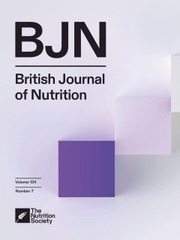Article contents
Effects of specific dietary sugars on the incorporation of 13C label from dietary glucose into neutral sugars of rat intestine and serum glycoproteins
Published online by Cambridge University Press: 09 March 2007
Abstract
Although theoretically all glycoprotein sugars can be derived from glucose, it may be hypothesized that specific dietary sugars could be preferential substrates for glycoprotein synthesis. To test this hypothesis, groups of rats received either continuously (continuous-labelling experiment) or for a single nutritional period (pulse-labelling experiment) a 13C-rich diet containing either maize starch or artificially labelled [13C]glucose. Some groups of rats were also provided during a single nutritional period with low amounts (20–200 mg/animal) of low-13C dietary sugars (mannose, galactose, fucose or fructose). If specific dietary sugars were preferentially incorporated into glycoproteins instead nf glucose-derived labelled sugars, a decrease would be expected in the intestinal or serum glycoprotein-sugar 13C enrichment monitored by gas chromatography-isotope-ratio mass spectrometry (GC-IRMS). Contrary to this hypothesis the results showed no significant decrease with any of the specific dietary sugars. Furthermore, with dietary low-13C mannose or galactose, a significant increase in 13C enrichment of glycoprotein-sugars was observed compared with some other nutritional groups. Moreover, in the pulse-labelling experiment, dietary mannose and galactose induced similar patterns of 13C enrichment in intestinal and serum glycoprotein-sugars. Therefore, although specific dietary sugars do not appear to be preferential substrates for glycosylation under conditions and doses relevant to current concepts of nutrition, regulatory roles of some specific dietary sugars in relation to glycoprotein-sugar metabolism might be hypothesized. These findings could lead to similar studies using stable-isotope methodology in man which could have practical consequences, especially in parenteral nutrition where glucose is the only sugar provided to the metabolism.
- Type
- Glycosylation and specific dietary sugars
- Information
- Copyright
- Copyright © The Nutrition Society 1995
References
- 4
- Cited by




